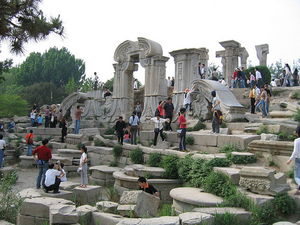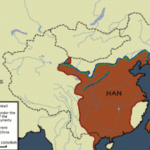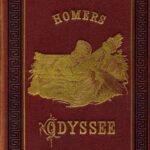The Old Summer Palace in Peking (now Beijing), China lays in ruins today. It was once an elaborate complex of gardens, waterworks and buildings of varying architectural styles. The buildings once contained one of the largest collections of Chinese art and literature ever held in one place. The complex was destroyed and now the ruins of Old Summer Palace serve as a sad reminder to the Chinese of the price of war.
The Old Summer Palace in Peking was commissioned by Emperor Kangxi as a gift for his son, who would later become Emperor Yongzheng. At the time the Old Summer Palace was referred to as the Imperial Gardens. Construction began on the Old Summer Palace in 1707. Eighteen years later, Yongzheng began expanding the complex his father had built by adding man-made lakes, streams and ponds as well as many of the gardens artworks. Emperor Qianlong also added to the palace and gardens. He incorporated European influenced architecture as well as Tibetan and Mongol style buildings. The Old Summer Palace came to be the official home of the Emperors. It operated much like the Forbidden City.
The Old Summer Palace complex spans 865 acres. There are three main Gardens in the complex, the Garden of Perfect Brightness, the Garden of Eternal Spring and the Elegant Spring Garden. The Chinese refer to Old Summer Palace as the Gardens of Perfect Brightness or the Garden of Gardens. At its peak the grounds contained beautiful fountains, buildings and architectural art.
At the time of its destruction in 1860, the Old Summer Palace housed an important collection of Chinese paintings, sculptures, jewelry, artifacts and literature. The gardens and buildings had been expanded and perfected for more than 150 years. It is hard to imagine the splendor of these intricate gardens and buildings in their prime, stretching over a manicured landscape eight times larger than Vatican City.
The looting that occurred in 1860 was a direct result of the Second Opium War. English and French troops were allowed to go to Peking and loot the complex and the Emperor was forced to flee to the Forbidden City. After the looting the royal buildings were burned for three days on the order of Lord Elgin.
Twenty British, French and Indian prisoners of War had been tortured and killed by the Chinese.The burning was ordered in retaliation for these losses. After the burning the foreign troops erected a sign that read “This is the reward for perfidy and cruelty.” A few buildings remained after the first burning, but they were destroyed by the Eight Nation Alliance during the Boxer Rebellion.
Today the Old Summer Palace ruins are a Chinese national historical site. Some of the artifacts that were looted are still on display in other countries. The Chinese view this as a shame and refuse to buy back the pilfered items. A new Summer Palace has since been constructed near the site of the Old Summer Palace, but it lacks the grandeur and scope of the original.
Sources
Old Summer Palace
Old Summer Palace, retrieved 7/5/09, absoluteastronomy.com/topis/Old_Summer_Palace, retrieved 7/5/09, chinatour360.com/beijing/yuanmingyuan.htm



